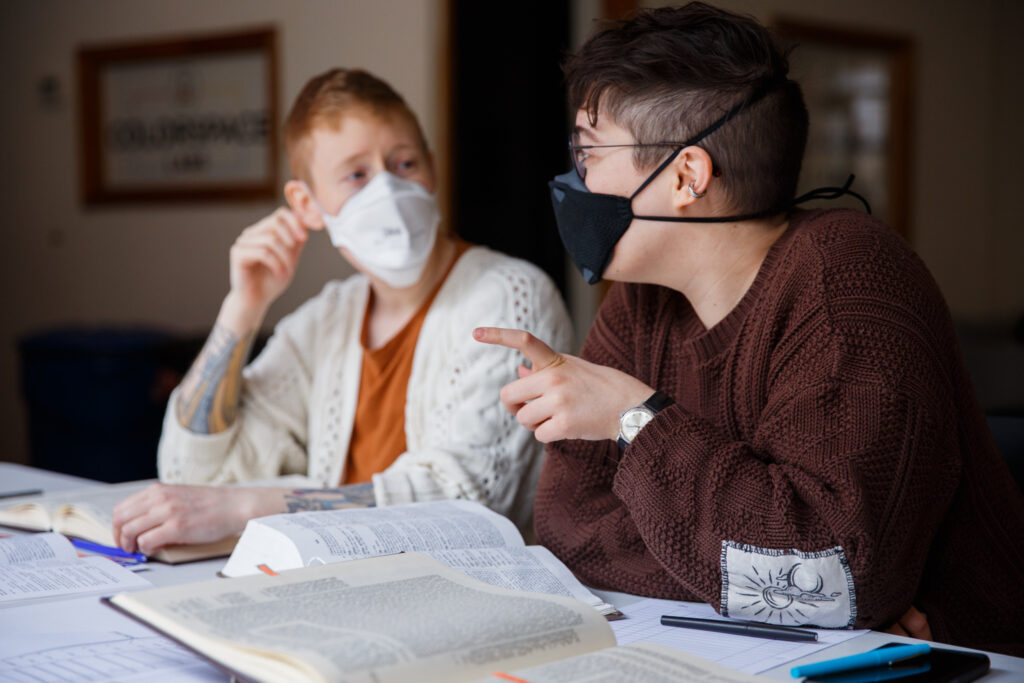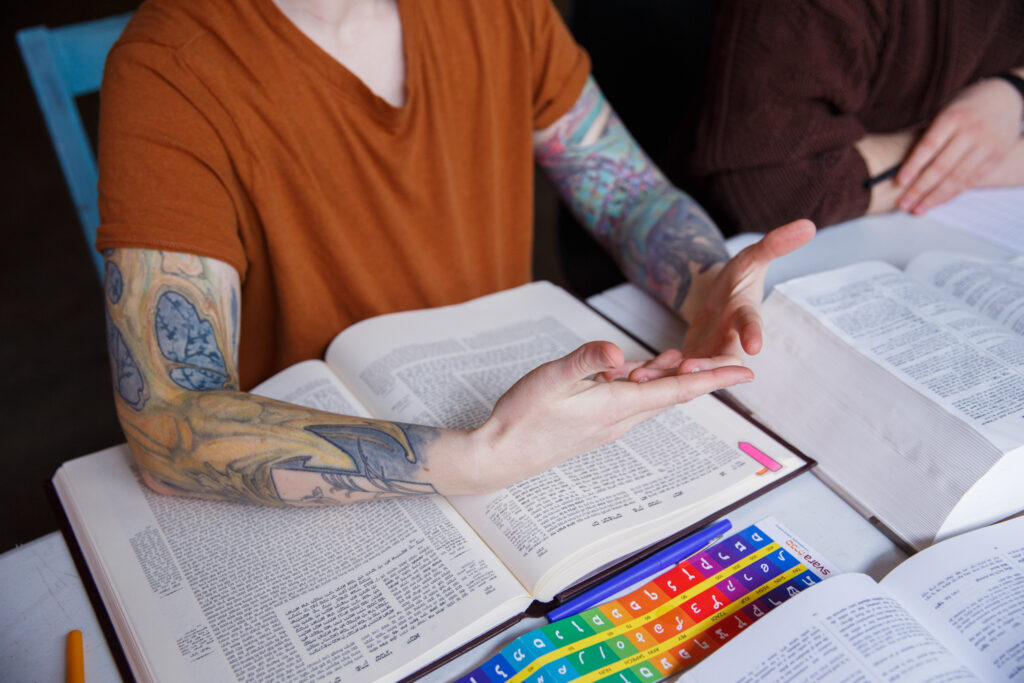There is no feeling like being in a full bet midrash. In the bet midrash I hear and feel the low hum of folks studying around me, and time is punctuated by the sound of chevruta high-fives and dictionary pages flipping. Surrounded by fellow seekers, tables of books, and unending snacks, pouring over open tractates of Talmud, the “house of study” has become a place where I come “home.” For me, this is revelation, and I think it was for the Rabbis, too.
The Revelation of Torah on Mount Sinai, our tradition tells us, was for all of us: we were all there– Jews of the past, along with all future Jewish people to come– at the foot of the mountain and we received Torah collectively. This is a defining feature of Torah, that we received it together, in community across time and space.
In the rabbinic imagination, studying Torah is a microcosm of Mount Sinai. Our Rabbis take this moment of collective revelatory experience and they tell us it is ours to access, whenever we want, whenever we take part in the central practice of the rabbinic project, the practice around which all others are shaped. Learning Torah becomes a pathway to bringing Sinai to us: in our daily lives we can manifest this moment into being: “each and every day the Torah is as dear to those who study it, as it was on the day it was given from Mount Sinai” (Berakhot 63b). Like the Revelation at Sinai, real learning happens collectively. Torah is acquired only in community (Berakhot 63b), the Rabbis teach. This feels so true to me—the learning that lives most deeply inside of me carries the energy of the bet midrash in which I’ve learned it. Torah is not an individual project; its unfolding teachings are shaped and passed down through relationships, through communities, and through chevrutot.
But now, as so many of us are heading into experiences of Shavuot in isolation, what are we to do without our communities? Knowing that the nature of Torah is to be learned in, with, and through a collective, what do we do when we are alone? Are we really learning Torah if we’re learning by ourselves?
We’re not alone in this question, as the Rabbis explore and defend this phenomenon of learning solo:
ומנין שאפילו אחד שיושב ועוסק בתורה ששכינה עמו שנאמר בכל המקום אשר אזכיר את שמי אבוא אליך וברכתיך
And what is the source (in the Torah) that proves that even one person sits and engages in Torah, that the Divine Presence is with them? It is said, “In every place where my name is mentioned, I (G!d) will come to you and bless you.” (Berakhot 6a)
Don’t worry, the Rabbis say. Even when you’re alone, learning Torah still works. Even when you think you’re on your own in a room with a text, the Shekhinah, G!d’s imminent and felt Presence, is with you. The Shekhinah is your chevruta.
This is an amazing moment of radical rabbinic theology. The Rabbis ask “And what is the source…” not “Is it so?” They don’t say “Is it possible that when we learn, even when we are alone, G!d’s presence is with us?” Their question assumes that the answer is already clear: yes, of course G!d is there. Their question assumes that they can and will find the answer within the Torah, knowing that their creative interpretation will lead them to locate a support for this practice, reading G!d’s presence into their lives when perhaps it’s not so obvious. The “prooftext” is a little bit odd, and Rashi helps us understand it: G!d speaks to us individually, saying ‘When my name is mentioned (Rashi: which is G!d’s words, the Torah, and mitzvot), I will come to you (Rashi: You, which is written in the singular) and bless you (Rashi: Again, singularly).
Throughout the pandemic, I’ve learned this sugya with dozens of chevrutot— I’ve prepped it with SVARA Fellows and Grassroots Leaders who’ve been teaching it in local batei midrash, I’ve joined chevrutas (as a fairy!) who are exploring this text together, and I’ve learned it with my own regular chevrutot, to bring comfort and grounding to our learning during this time of isolation. After learning this sugya throughout the pandemic with dozens of chevrutot, I’m now convinced that there is a deep truth contained in this teaching. I’ve felt this in my kishkes, in the deepest part of my gut, over these months.
In addition to studying with so many people in this time, I’ve also found myself learning alone more than ever before. As I’ve learned alone over these past months, I do feel less lonely. Certainly learning cannot fully repair our deepest moments of loneliness, but for me, it has helped.
Rebbe Nachman, a famously solitary Hassidic master, offers a teaching that helps me to understand why this claim has felt so true to me, capturing something deep about how learning continues to ease my loneliness:
“And the Oral Torah (Torah of the mouth), this is the Shekhina…And when one sits with the proper mindset and learns a judgement or a law that an earlier Sage originated, this brings into being the aspect of kisses (neshikin). Kisses are the binding of one spirit with another. For these teachings that the student is learning were spoken by an earlier sage, and speech acts as a life-force…When the Sage originates and speaks an insight, the speech itself is an aspect of Oral Torah that the Sage has originated…So now, when one learns this insight and brings the teaching and insight into their own mouth, the spirit of the Sage who originated this insight binds itself with the words of the one who is now studying. This binding of spirit with spirit is called ‘kissing.’
When we learn the teachings of others, we’re kissing them. Rebbe Nachman brings the embodied, intimate experience of reverent kissing into the bet midrash, suggesting that when we cite someone who came before us, when we read their teachings out loud, when we put their words in our mouths, our spirits become bound in a kiss. For Rebbe Nachman, this is one aspect of what “Shekhina,’ Divine Presence means. This is a G!d-place: finding the words of our ancestors moving in our mouths, connecting our spirits to theirs through speech and learning. When we bring this back to our sugya, Rebbe Nachman helps me express what’s been so powerful and healing for me about learning in this time. When we learn, we manifest and bring into being an intimate, sweet, tender moment with the Sages who taught the Torah that we are learning. When we speak, it is as though they are with us, speaking with and through us. The presence of the Shekhina really means, through this teaching from Rebbe Nachman, that the entire history of people speaking and breathing life into the Torah is present with us when we are alone.”
Learning Torah is the practice that I’ve had the most ease transitioning into during this pandemic moment. It’s been hard to explain why other practices, other forms of grounding and connection have felt so strange and lonely, while learning has simply…worked. Perhaps that’s because this is precisely what “Oral” Torah was made for: to be a kiss from our ancestors in our loneliest moments, assuring us that we are only a citation away from connection.







